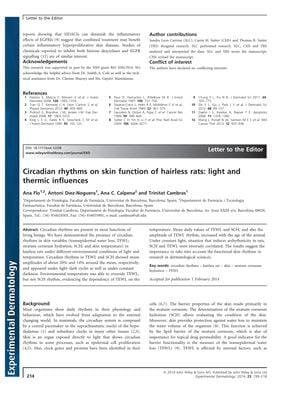Circadian Rhythms on Skin Function of Hairless Rats: Light and Thermal Influences
March 2014
in “
Experimental Dermatology
”

TLDR Light and temperature affect the daily skin function rhythms in hairless rats, with temperature influencing water loss but not skin hydration.
The study investigated the circadian rhythms of skin functions in eight male hairless rats, examining transepidermal water loss (TEWL), stratum corneum hydration (SCH), and skin temperature under different light and temperature conditions. Results showed that TEWL and SCH exhibited circadian rhythms with mean amplitudes of approximately 20% and 14%, respectively, which persisted in both light-dark cycles and constant darkness. TEWL was found to be temperature-dependent, as environmental temperature could disrupt its rhythm, while SCH rhythm remained unaffected. Additionally, as the rats aged, the mean daily values and amplitude of TEWL rhythm increased. Under constant light, which disrupts rats' circadian rhythms, an inverse correlation between SCH and TEWL was observed. The study, which took measurements every 2 hours for 24 hours over six days, suggests that skin function rhythms are important considerations in dermatological research. The research was funded by NIH grant R01 ES017014 and acknowledged contributions from Dr. Judith A. Cole, Dr. Clarisse Muenyi, and Ms. Gayatri Mamidanna.
